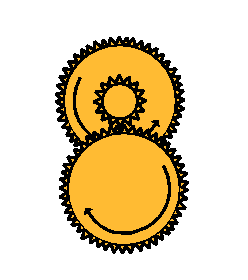Gear Train
From DT Online

Description
If a small driver gear meshes with the larger of two gears joined together on a common shaft then the smaller gear on that shaft will also rotate at the slower speed. The smaller gear can then be used to drive a large gear on a second shaft to cause a second gear reduction. This arrangement is known as a Gear Train and is a good way of ‘gearing down’ a rapidly revolving electric drive motor for example.
Features and Applications
The process can be repeated by engaging the smaller gear on the drive shaft with a large gear fixed to a small gear, but both loosely rotating, on an intermediate ‘Layshaft’ and this second small gear used to drive a large gear on the final output shaft. If even greater speed reductions are required, additional ‘layshafts’ can be used and the process repeated again. The use of ‘layshafts’ is common in car gearboxes for example.
To calculate the total ‘gearing down’ (or ‘gearing up’ if the roles of large and small gears are reversed), the ‘gear ratio’ for each meshing pair of gears is calculated and the result from each pair in the ‘gear train’ multiplied together. For example, a 20mm dia driver gear meshes with a 60mm dia gear which is connected to a 20mm gear on a layshaft and this in turn meshes with a 60mm dia gear on the output shaft. Each meshing pair has a gear ratio of 3:1 so the overall gear ratio is 9:1.
Note:If two meshing gears have the same number of teeth, they will rotate at the same speed, however if they have different numbers of teeth then the gear with fewer teeth will rotate more quickly - i.e. the Velocity Ratio (or ‘Gear Ratio’) of a pair of meshing gears is given as the Number of Teeth of the Driver Gear divided by the Number of Teeth of the Driven Gear. The Mechanical Advantage (or ‘Torque Ratio’) similarly is given as No. of Teeth on Driven divided by No. of Teeth on Driver.
|
Click top left to enlarge |






